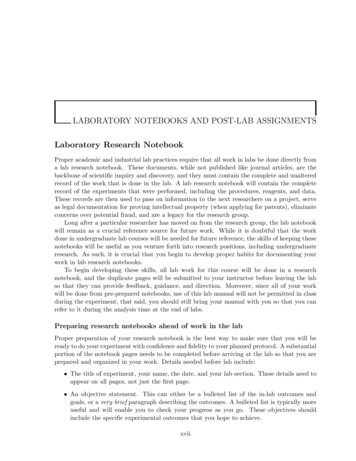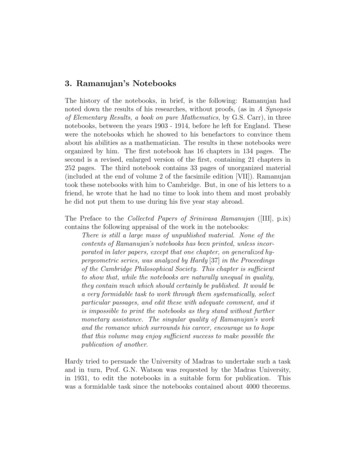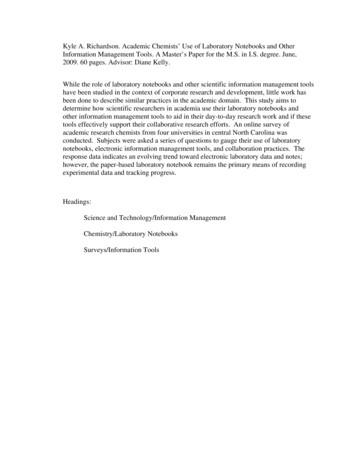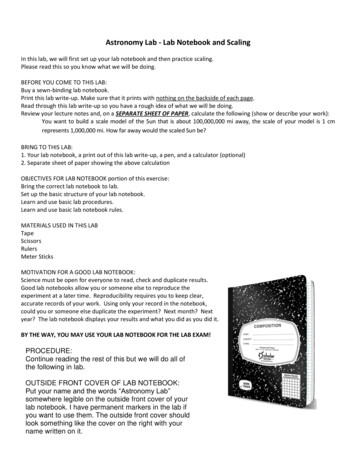
Transcription
LABORATORY NOTEBOOKS AND POST-LAB ASSIGNMENTSLaboratory Research NotebookProper academic and industrial lab practices require that all work in labs be done directly froma lab research notebook. These documents, while not published like journal articles, are thebackbone of scientific inquiry and discovery, and they must contain the complete and unalteredrecord of the work that is done in the lab. A lab research notebook will contain the completerecord of the experiments that were performed, including the procedures, reagents, and data.These records are then used to pass on information to the next researchers on a project, serveas legal documentation for proving intellectual property (when applying for patents), eliminateconcerns over potential fraud, and are a legacy for the research group.Long after a particular researcher has moved on from the research group, the lab notebookwill remain as a crucial reference source for future work. While it is doubtful that the workdone in undergraduate lab courses will be needed for future reference, the skills of keeping thesenotebooks will be useful as you venture forth into research positions, including undergraduateresearch. As such, it is crucial that you begin to develop proper habits for documenting yourwork in lab research notebooks.To begin developing these skills, all lab work for this course will be done in a researchnotebook, and the duplicate pages will be submitted to your instructor before leaving the labso that they can provide feedback, guidance, and direction. Moreover, since all of your workwill be done from pre-prepared notebooks, use of this lab manual will not be permitted in classduring the experiment; that said, you should still bring your manual with you so that you canrefer to it during the analysis time at the end of labs.Preparing research notebooks ahead of work in the labProper preparation of your research notebook is the best way to make sure that you will beready to do your experiment with confidence and fidelity to your planned protocol. A substantialportion of the notebook pages needs to be completed before arriving at the lab so that you areprepared and organized in your work. Details needed before lab include: The title of experiment, your name, the date, and your lab section. These details need toappear on all pages, not just the first page. An objective statement. This can either be a bulleted list of the in-lab outcomes andgoals, or a very brief paragraph describing the outcomes. A bulleted list is typically moreuseful and will enable you to check your progress as you go. These objectives shouldinclude the specific experimental outcomes that you hope to achieve.xvii
xviii · Quantitative General Chemistry Lab Manual A detailed procedure. Most often you will be following a procedure that has been providedto you. In this case there is no need for you to copy the procedure verbatim; rather, makesure that the procedure you write is detailed enough for you to follow and includes allof the pertinent details that are necessary. Add extra details where you think you mightneed them, and omit others that you find to be overly verbose. Make sure to diagram anyapparatus that will be used, if applicable. For multiple dilutions it will help to diagramor sketch these dilutions (to make sure that they are clear). Safety information and potential hazards. Labs can be a dangerous place, and knowingabout the potential hazards in advance is the best way to avoid potentially-harmful situations. Any and all chemical, or physical, hazards related to the experiment must belisted and explained inside the procedure. Consider making ‘warning’ boxes in yourprocedure. Waste handling instructions. A detailed description of how all the waste components willbe handled. This must be include inside your procedure write-up, not at the end. Data tables. Tables, placed next to the procedural steps that are relevant to the datacollection, for the values that you expect to collect/measure must be prepared in advanceof the lab session. This is the best way to make sure that you will have all of theinformation that you need once you leave the lab. In the fast-paced, sometimes nervewracking, laboratory setting it is easy to miss important details; having tables set upin-advance allows you to see, at a quick glance, what exactly you’ll need to record. Observations. While these observations will be made during the performance of theexperiment, make sure to leave ample room for you to document what you observe asyour do the experiment.Examining a sample notebook entryThe sample notebook entry in Figure 1 highlights a few important things to keep in mind whenpreparing your lab notebook. Specifically: All of the important information at the top has been filled-in, on all pages, before lab. Objectives are listed in a concise way that allows the student to easily identify objectivesleft to complete. Appropriate room for observations is left next to the procedure, and the observations madein lab are detailed enough to be understandable. Some students prepare their notebookpages in one color pen (black ink, for instance) and make observations and record data inanother (red or blue ink) – this can be very helpful for working with your notes. Tables are prepared, before coming to lab, for all of the data that will need to be recorded. Waste and safety concerns are listed inside the procedure.It is also important to note that procedure is written in a way that the student can easilyfollow – a lot of details when necessary and fewer details when appropriate. Notice the twoversions of step #5; it is likely that the first version might show up early on in the year, whereasthe second version would be used as the student develops more comfort and confidence.
Laboratory Notebooks and Post-Lab Assignments · xixN/A(50 mL)Figure 1: Sample notebook entry that highlights important aspects to a successful researchnotebook.
xx · Quantitative General Chemistry Lab ManualWorking with research notebooks in the labIn the lab, all work must be done directly from and in the lab notebook – this includes recordingall data, including seemingly insignificant information and observations. For professionals, thisis to ensure the strongest levels of integrity. For students, this is good training for futureresearch positions, and limited reliance on memory. The following items are added to yourresearch notebook during the experiment: Name(s) of any co-investigators that are actively working with you on a protocol (labpartners) or supervisor (if applicable). Observations. A researcher needs to take detailed notes and write their observationsduring an experiment – both planned and unplanned information. Actual times, colorsand color changes, temperatures, and deviations from the written procedure are some ofthe observations that you should be making in the lab. These are immeasurably helpfulfor people who will want to reproduce your work and for yourself. Needless to say, alldata must be recorded in the notebook. Data. All data must be recorded directly into the notebook using the tables that wereconstructed before the lab. This includes masses, volumes, and other exact measurementsthat are recorded in the lab. Data or spectra recorded on instruments should be mentionedin the notebook pages and a note about where it is stored. Always keep an unedited copyof all data files, and work from the copy. Calculations. It is sometimes helpful, though not always necessary, to perform somepreliminary calculations in your notebook. Include interpretations of those data, whenapplicable. Instruments. It is important to note pertinent details about instruments used in anexperiment when the choice of instrument has a potential impact on the experiment.Glassware (burettes, pipettes, etc.) is rarely included in this category. Conversely, thingslike spectrophotometers, pH meters, thermometers, centrifuges, and cell culture tablesshould all be well-documented – including make, model, and settings used.General notebook practices and guidelines Entries must be written in pen, not pencil. Never use error correction fluid or pens. When you make errors, simply draw a line through the incorrect entry and enter thecorrect information. Do not scribble. Write your initials next to the correction andinclude the data the correction was made. It is also useful to provide a reason for thecorrection, if applicable. Never remove a page from a research notebook (except for the duplicate copies that aresubmitted in lab courses), and never skip pages. If you accidentally skip a page, or makea large mistake, cross out the page and provide an explanation. The entries should be legible, and information should be organized and clearly labeled.
Laboratory Notebooks and Post-Lab Assignments · xxi Use lots of space. Lab notebook should be geared toward functionality and legibility, notsaving space. Make a note in your observations about any data that is recorded on external instruments.Include a description of what is recorded, where it is saved, and the filename. Always include the make and model of analytical instrumentation (spectrometers, pH meters, etc. – pretty much anything that uses electricity). Also, make sure to document thespecific instrument parameters that are used in your experiment (calibrations, samplingfrequency, etc.). Students will submit the duplicate pages of their research notebooks before leaving thelab. You should submit the copies (not the originals), as you will want the originals –which are easier to read – to work from after the lab.Post-lab AssignmentsAfter completing an experiment, you will be expected to complete and submit a post-lab assignment. These assignments will typically be comprised of your data analysis and a series ofconceptual questions related to the lab. On occasion, you will also be asked to write a scholarlypaper related to the experiment. Important note: scholarly papers are only required forcertain experiments. The details about each experiment’s post-lab assignment are found afterthe procedure.The post-lab assignment that you submit must constitute your own intellectual propertyand e ort. In other words: they are individual work only. That said, you are highly encouragedto discuss your work with your peers, get support and guidance from your instructors, andwork in groups as you complete these assignments. Detailed guidelines concerning group workare provided in the previous part of the lab manual under Professional Standards in ChemistryLabs.Submitting post-lab assignmentsTypically, post-lab assignments will be submitted on Blackboard using TurnItIn, and are duetwo hours before the start of the next lab period. Your instructor will announce any changesin the due dates of these assignments, if applicable.While TurnItIn will accept a few di erent file types for submission, it is important thatyou always submit your assignment as a PDF file – Word for PC and MAC can both producePDF files from your documents. Submitting your assignment in another form (e.g., as a docxMicrosoft Word file) will cause major (bad) structural changes to your paper. Submitting aPDF file, on the other hand, will make it so that the instructor will evaluate the paper as youintended them to see it.Finally, all success TurnItIn submissions will result in a confirmation email being sent toyour school email address a few minutes after the file is accepted. Always make sure thatyou’ve received your email confirmation that the assignment has been received. If you don’tget a submission receipt within 30 minutes, submit your assignment again as it has not actuallybeen received. It is your responsibility to ensure that your work is successfully submitted andreceived.
xxii · Quantitative General Chemistry Lab ManualGeneral guidelines for post-lab questionsConsider the following important guidelines for post-lab assignments: Answers to the post-lab questions must be typed. Typed equations need to include unitsand be formatted in an appropriate manner such that they are legible and straightforwardfor the instructor to read. This can be accomplished by using the equation editor in Microsoft Office or LATEX. Refer to Lab #1 and Writing Chapter 2 for additional suggestionsand guidelines about typesetting equations, and more. Make sure that the instructor willbe able to follow your work without difficulty. The questions must appear in the correct order, including all exhibits (tables, figures).Note: “Questions for Thought” are not optional, thought-provoking questions; rather,they are questions to be answered after you’ve completed your analysis. Often, thesequestions will tie together di erent concepts and require some research. You do not need to copy the question text into your assignment – that is an unnecessarywaste of your e ort and time. For multiple trials of the same experiment, only one full set of calculations need be shownfor each question. For replicate calculations, the results can be summarized using appropriate statistics and, when necessary or relevant, presented in a table or list. The followingcalculations never need to be shown: average/mean and standard deviation. In all cases,how the values were calculated must be stated explicitly. You are never required to show how average and standard deviation are computed manually – it is expected that you used Excel or a similar package to compute the average. Allother calculations, however, need to included. For example: when computing a 95% confidence interval, make sure to explicitly include the expression for the confidence intervalwith the proper values of s, t, and N . A large portion of each lab is the data analysis that you will perform; it is crucial thatyour work be legible and organized. Instructors will not evaluate work that is not properlyorganized or prepared.Successfully approaching your post-lab assignmentsConsider the following general suggestions for success in preparing your post-lab assignments: Read the post-lab assignment questions before going to lab. Have in mind the questionsthat you will need to answer while you are doing the lab. Talk to your lab instructor andpeers; they will likely be able to give you good insight into these concepts. While most of the experiments that you will perform do not take the full lab time, itis expected that students will remain in lab for the entire assigned time. During allremaining lab time, after the experiment is complete, students will begin working on theirdata analysis and post-lab assignments. Start working up your data as soon as possible. While you will begin the analysis in lab,it is unlikely that you will finish all of your post-lab assignment during the lab time. It
Laboratory Notebooks and Post-Lab Assignments · xxiiiis highly advisable to set-aside time soon after the lab ends – either later that day or thenext day – to complete the post-lab assignment. Previous students have confirmed thatworking on the post-lab assignments immediately after the lab substantially reduces thetime that needs to be spent completing them. One of the reasons for this is that, as timepasses, it is natural that you will start to forget exactly what you had done in the lab and,therefore, will end up spending a lot of time trying to remember what you did. Instead,it is most advisable to start working on the analysis immediately (within 24 hours), whilethe material is fresh. Working in groups, or at office hours, on the data analysis and questions for thought canbe very helpful. Don’t copy another student’s work, but work together to decide whatyou need to do to analyze your data. Never give your work to anyone else, even if youworked together, or collaborate on documents. See detailed notes on academic integrityin the section on Professional Standards. Plan your research: what do you know? What don’t you know? About which topics doyou need more information in order to understand the outcomes of your experiment? Use previous assignments, and “Questions for Thought,” to help guide you in your work.As the course proceeds, less information will be given and more thoughtfulness will beexpected. Using Google to do research can be good when the thing you are looking for is ratherstraightforward: the molecular weight of a compound, the structure of a molecule, or othertrivia that are commonly known and likely to be correct (thermodynamic data, commonchemical reactions, etc.). Unfortunately, however, many websites – including those with.edu extensions (i.e., schools and faculty webpages) – contain information that is factuallyerroneous. Moreover, it can be very difficult to discern good information from things thatare outright incorrect on the internet. Writing Chapter 6 contains detailed insight andguidance on locating and referencing useful information. When looking for information to supplement your understanding about the systems, techniques, and processes that we will study, make sure to search for and use good informationfrom authoritative sources. Use peer-reviewed textbooks, reference manuals (such as theCRC Handbook of Chemistry and Physics), journal articles, and review articles, most ofwhich can be easily accessed online. Use scholar.google.com to help refine web searchesto include mostly scholarly sources. Finding good sources of information can be tough atfirst – come to office hours and speak with your instructor in lab to work on these skills. Asking questions is the best way to get insight and answers that you are seeking. Attending office hours and study groups will substantially improve your productivity and thequality of your work.Scholarly PapersMost experiments will not involve writing a scholarly paper based on your experiment, andyour instructors will make sure to indicate when a scholarly paper is expected. The last part
xxiv · Quantitative General Chemistry Lab Manualof this lab manual is the Undergraduate’s Guide to Writing Chemistry Papers – a detailed explanation of the nature of scholarly papers and guidance for how they are prepared e ectively.While you may not need this entire guide for this course, previous students have found this tobe an indispensable tool for future work in other courses and their research.Consider the following important guidelines for post-lab assignments that involve writing scholarly papers: Scholarly papers will contain three sections: (a) paper, (b) references, and (c) supportinginformation. Papers and references must be typed (including equations) for all sections (including thesupporting information, which contains the calculations, data analysis, and questions forthought). Typed equations need to include units and be formatted in an appropriatemanner such that they are legible and straightforward for the grader to read. This can beaccomplished by using the equation editor in Microsoft Office or LATEX. See Lab #1 andWriting Chapter 2 for additional suggestions and guidelines about typesetting equationsand more. The supporting information (data analysis and questions for thought) must be completeand in the appropriate order – all of the instructions for post-lab assignments (above)apply to these sections. Exhibits (tables, figures) that will be presented in the paperalso appear in the appropriate place in the supporting information. Any “Questions forThought” should also be answered at the end of your Supporting Information section.In general, these questions provide good insight into the types of things that could bediscussed in the paper. A scholarly paper will always start on a new page. An appropriate title and the name(s)of the author(s) should appear at the beginning of the paper. References do not starton a new page; rather, they follow immediately after the conclusion of the paper, beforethe Supporting Information. The Supporting Information may have a separate referencessection at the end if you used references in preparation of the Supporting Informationthat were not necessarily included in the paper.
The sample notebook entry in Figure 1 highlights a few important things to keep in mind when preparing your lab notebook. Specifically: All of the important information at the top has been filled-in, on all pages, before lab. Objectives are listed in a concise way that allows the student to easily identify objectives left to complete.










